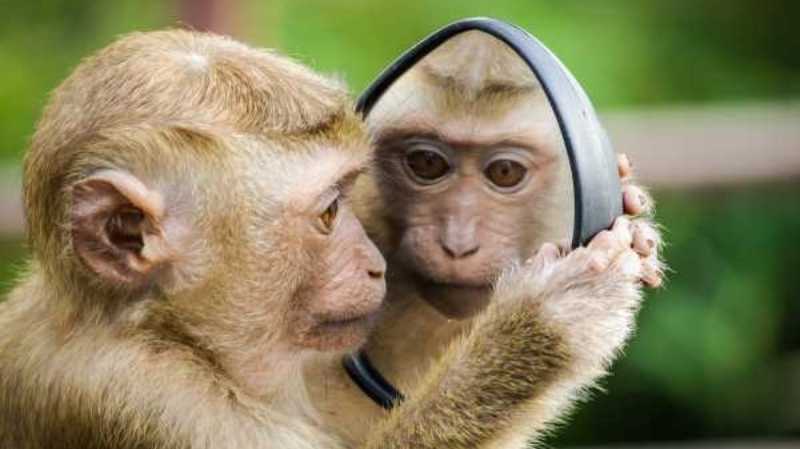Labour in the Transition from Ape to Man
6 minutes • 1185 words
Table of contents
I
Political economists assert that nature is the source of the materials that human labour converts into wealth.
Labour thus is:
- the source of all wealth.
- the prime basic condition for all human existence
In fact, labour created man himself.
Towards the end of the Tertiary period, as called by geologists, a highly-developed race of anthropoid apes lived somewhere in the tropical zone – probably on a great continent that has now sunk to the bottom of the Indian Ocean. [1]
Charles Darwin has given us an approximate description of these ancestors of ours. They:
- were completely covered with hair
- had beards and pointed ears
- lived in bands in the trees.
Hands
Their hands had different functions than the feet when climbing. They began to lose the habit of using their hands to walk and adopted a more and more erect posture.
- This was the decisive step in the transition from ape to man.

All extant anthropoid apes can stand erect and move about on their feet alone, but only in case of urgent need and in a very clumsy way.
- Their natural gait is in a half-erect posture and includes the use of the hands.
- The majority rest the knuckles of the fist on the ground and, with legs drawn up, swing the body through their long arms.
In general, all the transition stages from walking on all fours to walking on two legs are still to be observed among the apes today.
- The latter gait, however, has never become more than a makeshift for any of them.
If erect gait among our hairy ancestors became first the rule and then, in time, a necessity, other diverse functions have devolved on the hands.
The apes use their hands and the feet differently.
- In climbing, the hands and feet have different uses.
- The hands are used mainly for gathering and holding food in the same way as the fore paws of the lower mammals are used.
Many apes use their hands to build themselves nests in the trees or even to construct roofs between the branches to protect themselves against the weather, as the chimpanzee, for example, does.
- They grasp sticks with their hands to defend themselves against enemies, or bombard their enemies with fruits and stones.
- In captivity, they use their hands for a number of simple operations copied from human beings.
It is in this that one sees the great gulf between the undeveloped hand of apes and the human hand.
- The number and general arrangement of the bones and muscles are the same in both hands.
- But the hand of the lowest savage can perform hundreds of operations that no simian hand can imitate – no simian hand has ever fashioned even the crudest stone knife.
Our ancestors learned to adapt their hands through very simple operations during the transition from ape to man. The lowest savages are nevertheless far superior to these transitional beings.
Before the first flint could be fashioned into a knife by human hands, a period of time probably elapsed in comparison with which the historical period known to us appears insignificant.
In time, hands gained ever greater dexterity. Greater flexibility thus was acquired and increased from generation to generation.
Thus, the hand is not only the organ of labour, it is also the product of labour.
The human hand was perfected only through labour. This led to:
- adaptation to ever new operations
- improvement of muscles, ligaments, and bones
But the hand did not exist alone. It was only one member of an integral, highly complex organism.
What benefited the hand, benefited also the whole body in 2 ways.
- The body benefited from the Darwinian law of correlation of growth
This law states that the specialised parts of a plants and animals are connected to other non-specialized parts that apparently unconnected with them.
Thus, all animals, without exception, have lacteal glands for suckling their young if they meet the following criteria:
- have red blood cells without cell nuclei
- have their heads attached to the first vertebra by means of a double articulation (condyles)
Similarly:
- a mammal which has a multiple stomach for rumination always has cloven hoofs.
- perfectly white cats with blue eyes are almost always deaf.
Changes in certain forms will change the other parts of the body, although we cannot explain the connection.
- It changed other parts of the organism
Mastery over nature began with the development of the hand, with labour, and widened man’s horizon at every new advance. He was continually discovering new, hitherto unknown properties in natural objects.
On the other hand, the development of labour necessarily helped to bring the members of society closer together by:
- increasing cases of mutual support and joint activity
- making clear the advantage of this joint activity to each individual.
In short, men in the making arrived at the point where they had something to say to each other.
Necessity created the organ.
The undeveloped larynx of the ape was slowly but surely transformed by modulation to produce constantly more developed modulation, and the organs of the mouth gradually learned to pronounce one articulate sound after another.
Comparison with animals proves that this explanation of the origin of language from and in the process of labour is the only correct one.
The little that even the most highly-developed animals need to communicate to each other does not require articulate speech. In its natural state, no animal feels handicapped by its inability to speak or to understand human speech.
It is quite different when it has been tamed by man. The dog and the horse, by association with man, have developed such a good ear for articulate speech that they easily learn to understand any language within their range of concept.
Moreover they have acquired the capacity for feelings such as affection for man, gratitude, etc., which were previously foreign to them. Anyone who has had much to do with such animals will hardly be able to escape the conviction that in many cases they now feel their inability to speak as a defect, although, unfortunately, it is one that can no longer be remedied because their vocal organs are too specialised in a definite direction.
However, where vocal organs exist, within certain limits even this inability disappears. The buccal organs of birds are as different from those of man as they can be, yet birds are the only animals that can learn to speak; and it is the bird with the most hideous voice, the parrot, that speaks best of all.
The parrot does not understand what it says. It will chatter for hours, continually repeating its whole vocabulary. But within the limits of its range of concepts it can also learn to understand what it is saying.
Teach a parrot swear words in such a way that it gets an idea of their meaning (one of the great amusements of sailors returning from the tropics). Tease it and you will soon discover that it knows how to use its swear words just as correctly as a Berlin costermonger.
The same is true of begging for titbits.






